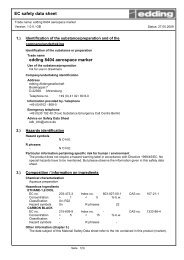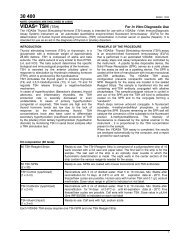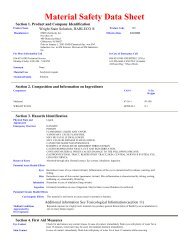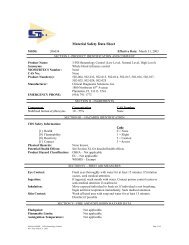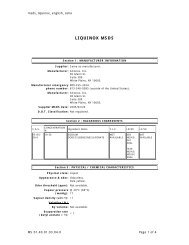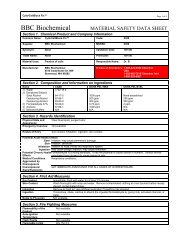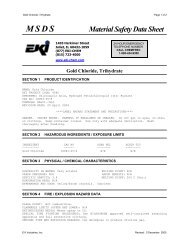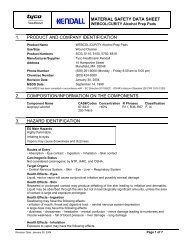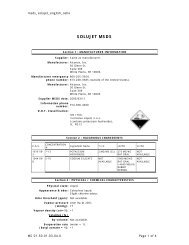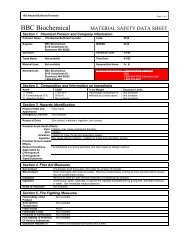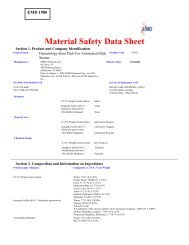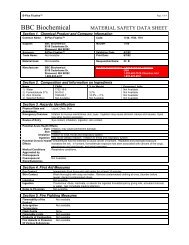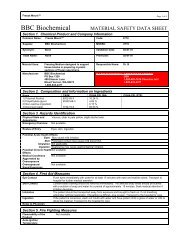Material Safety Data Sheet - Mercedes Medical
Material Safety Data Sheet - Mercedes Medical
Material Safety Data Sheet - Mercedes Medical
You also want an ePaper? Increase the reach of your titles
YUMPU automatically turns print PDFs into web optimized ePapers that Google loves.
<strong>Material</strong> <strong>Safety</strong> <strong>Data</strong> <strong>Sheet</strong>Not classified as Hazardous according to criteria of Worksafe AustraliaNot classified as Hazardous according to Occupational <strong>Safety</strong> and Health Administration’s(OSHA) Communication Standard, 29 CFR 1910.1200Gamma GT1. CHEMICAL PRODUCT AND COMPANY IDENTIFICATIONTHERMO ELECTRONTHERMO ELECTRON189 - 199 Browns Rd 331 South 104 th StreetNOBLE PARK VIC 3174 LOUISVILLE, CO 80027AUSTRALIAU.S.ATel: +61 3 9790 4100 Tel: (303) 581 6428Fax: +61 3 9790 4155 Fax: (303) 581 6429E-mail: info.clinicalchemistry@thermo.comE-mail: info.clinicalchemistry@thermo.comProduct Name: Gamma GTCatalog Numbers: 1460-200Use: This reagent is intended for in vitro quantitative determination of gamma -glutamyltransferase (GGT) [gamma-Glutamyltransferase, EC2.3.2.2], in human serum or plasma.UN Number: None allocatedProper Shipping Name: NONE ALLOCATEDDangerous Goods Class: None allocatedSubsidiary risk: None allocatedPacking Group: None allocatedHazchem Code: None allocatedPoison Schedule: None allocatedContact PointAustraliaU.S.AQuality Assurance Manager:ChemtelTel: +61 3 9790 410024 Hour Emergency AssistanceMon – Fri 9:00am to 5:00pm 1-800-255-39242. COMPOSITION / INFORMATION ON INGREDIENTSSUBSTANCE NAME Proportion CAS NumberAll ingredients in this product are not hazardous according to the criteria of Worksafe Australia and OSHACommunication Standard 29 CFR 1910.1200.3. HAZARD IDENTIFICATIONNot Classified as hazardous according to the criteria of Worksafe Australia and OSHA Communication Standard 29CFR 1910.1200.Hazard Category: None allocatedACUTE HEALTH EFFECTSSwallowed:Reagent 1Swallowing large quantities may cause irritation to mouth, throat and stomach, which may lead to nausea, vomiting anddiarrhoea.Reagent (R1A)Drinking large quantities of this product, may cause irritation to mouth, throat and stomach with effects includingmucous build up, irritation to the tongue and lips and pains in the stomach, which may lead to nausea, vomiting anddiarrhoea.Eye:May cause mechanical irritation to the eyes, with effects including: tearing, pain, stinging and blurred vision. Theseeffects are anticipated to be of a transient (short acting) nature and no long term injury is envisaged.Page 1 of 5 Issue Date: October 2003 PI750040C.00
<strong>Material</strong> <strong>Safety</strong> <strong>Data</strong> <strong>Sheet</strong>Not classified as Hazardous according to criteria of Worksafe AustraliaNot classified as Hazardous according to Occupational <strong>Safety</strong> and Health Administration’s(OSHA) Communication Standard, 29 CFR 1910.1200Gamma GT3. HAZARD IDENTIFICATION (cont)Skin:May cause irritation to the skin.Inhaled:Reagent 1May cause irritation to the mouth, throat and upper respiratory system.Reagent (R1A)If the product is heated, the mists generated from this product may cause irritation to the mouth, throat and upperrespiratory system.Chronic:Prolonged or repeated inhalation of the dust may cause sneezing, coughing and mucous buildup.4. FIRST AID MEASURESSwallowed:If swallowed, DO NOT induce vomiting. If conscious, give 1 to 2 glasses of water to drink. Seek immediate medicalassistance.Eye:If material is splashed into eyes, immediately, flush with plenty of water for 15 minutes, ensuring eye lids are heldopen. If irritation persists transport to hospital or doctor.Skin:If material is splashed onto the skin, remove any contaminated clothing and wash skin thoroughly with soap and water.If irritation persists transport to hospital or doctor.Inhaled:Move victim to fresh air. Apply resuscitation if victim is not breathing.First Aid Facilities:Eye wash fountain, safety shower and normal wash room facilities.Advice to Doctor:Treat symptomatically.In case of poisoning, contact Poisons Information CentreIn Australia call Tel: 131126In New Zealand Tel: 0347470005. FIRE-FIGHTING MEASURESFire/Explosion HazardIf safe to do so, move undamaged containers from fire area.Hazardous Decomposition Products:Reagent 1Decomposes on heating emitting noxious smoke.Reagent (R1A)Decomposes on heating emitting oxides of carbon and oxides of nitrogenFire Fighting Procedures: Fire fighters to wear Self-contained breathing apparatus (SCBA) in confined spaces, inoxygen deficient atmospheres or if exposed to products of decomposition. Full protective clothing is also recommended.Extinguishing Media: Use extinguishing media suitable for surrounding fire situation.Page 2 of 5 Issue Date: October 2003 PI750040C.00
<strong>Material</strong> <strong>Safety</strong> <strong>Data</strong> <strong>Sheet</strong>Not classified as Hazardous according to criteria of Worksafe AustraliaNot classified as Hazardous according to Occupational <strong>Safety</strong> and Health Administration’s(OSHA) Communication Standard, 29 CFR 1910.1200Gamma GT5. FIRE-FIGHTING MEASURES (cont)FlammabilityReagent 1This material is not a combustible or flammable solid.Reagent (R1A)This material is not a combustible or flammable liquid.6. ACCIDENTAL RELEASE MEASURESReagent 1Avoid generating dusts. Wear suitable protective equipment. Ventilate area. If possible wet area down to prevent highdust levels. If available, use dustless methods, such as a HEPA vacuum and filter. Otherwise, use a non-sparking shoveland place into a suitably labeled container for later disposal. Do not dry sweep.Reagent (R1A)Walk cautiously. Ventilate area. Wear protective equipment to prevent skin and eye contact, as outlined under personalprotection in this MSDS. If large quantities of this product have spilt, then bund area using sand or soil - to prevent runoff into drains and waterways. Throw absorbent (vermiculite or other inert material) onto spill. Scoop up and seal inproperly labeled containers for disposal. For small spills (less than 1 L) flush to drain with large quantities of water.7. HANDLING AND STORAGEReagent 1Avoid generating dusts. Store in a cool place and out of direct sunlight. Store away from oxidizing agents. Keepcontainers closed, when not using the product. Store at 2-8°C and the reagent will be stable until the expiry date statedon the bottle and kit box labels. Store in original packages as approved by manufacturer.Reagent (R1A)Store in a cool place and out of direct sunlight. Store away from oxidizing agents. Keep containers closed, when notusing the product. Store at 2-8°C and the reagent will be stable until the expiry date stated on the bottle and kit boxlabels. Store in original packages as approved by manufacturer.8. EXPOSURE CONTROLS / PERSONAL PROTECTIONExposure StandardsReagent 1No exposure standards are available for this product, however, the nature of the product is a dust therefore it isrecommended that an exposure standard of 10 mg/m³ for an eight hour exposure based upon Nuisance dust.Reagent (R1A)No exposure standards are available for this product.Engineering ControlsMaintain adequate ventilation at all times. In most circumstances natural ventilation systems are adequate .Personal Protection EquipmentGLOVES: Not normally required, however, for people with sensitive skins the use of neoprene or nitrile isrecommended.EYES : Spectacles with side shields to protect eyes.RESPIRATORY PROTECTION: Avoid breathing of dusts. The use of a respirator is not normally required,however, if high dust levels are present, then the use of a suitable dust mask or half-face respirator fitted with a P1 filteris recommended. All respirators must comply with AS/NZS 1715 and AS/NZS 1716.Page 3 of 5 Issue Date: October 2003 PI750040C.00
<strong>Material</strong> <strong>Safety</strong> <strong>Data</strong> <strong>Sheet</strong>Not classified as Hazardous according to criteria of Worksafe AustraliaNot classified as Hazardous according to Occupational <strong>Safety</strong> and Health Administration’s(OSHA) Communication Standard, 29 CFR 1910.1200Gamma GT9. PHYSICAL AND CHEMICAL PROPERTIESReagent 1Reagent (R1A)Appearance: White to pale yellow powder with no odour. Clear liquid with no odour.Boiling Point: Not available. Not available.Freezing Point: Not available. Not available.Vapour Pressure: Not available. Not available.Specific Gravity: Not available. Not available.Flash Point: Not applicable. Not applicable.Flammability Limits: Not applicable. Not applicable.Solubility in Water: Completely miscible. Completely miscible.Other PropertiespH: Not available. 8.0 - 8.15 at19-22 o C10. STABILITY AND REACTIVITYSTABILITY:Stable under normal conditions of use.HAZARDOUS DECOMPOSITION PRODUCTS:Reagent 1Decomposes on heating emitting noxious smoke.Reagent (R1A)Decomposes on heating emitting oxides of carbon and oxides of nitrogen.HAZARDOUS POLYMERIZATION:Will not occur.INCOMPATIBILITIES:Strong oxidizing agents.CONDITIONS TO AVOID:Reagent 1Generation of high dust levels and incompatibles.Reagent (R1A)Generation of mists.11. TOXICOLOGICAL INFORMATIONThere is no toxicological information available for this product, the following is expected:Oral LD50(rat): > 5,000 mg/kgDermal LD50(rabbit): > 5,000 mg/kg12. ECOLOGICAL INFORMATIONNo ecological information available for this product. Do not dispose of large quantities to waterways, drains or sewers.13. DISPOSAL CONSIDERATIONSRefer to appropriate authority in your State. Normally suitable for disposal by approved waste disposal agentPage 4 of 5 Issue Date: October 2003 PI750040C.00
<strong>Material</strong> <strong>Safety</strong> <strong>Data</strong> <strong>Sheet</strong>Not classified as Hazardous according to criteria of Worksafe AustraliaNot classified as Hazardous according to Occupational <strong>Safety</strong> and Health Administration’s(OSHA) Communication Standard, 29 CFR 1910.1200Gamma GT14. TRANSPORT INFORMATIONUN Number: None allocatedProper Shipping Name: NONE ALLOCATEDDangerous Goods Class: None allocatedSubsidiary risk: None allocatedPacking Group: None allocatedHazchem Code: None allocatedNot classified as a Dangerous Good according to the Australian Code for the Transport of Dangerous Goods by Roadand Rail (ADG Code) 6th Edition. Not classified as a Dangerous Good according to the UN, DOT(US), ICAO(IATA)or IMO(IMDG).15. REGULATORY INFORMATIONPoison Schedule: None allocatedRISK PHRASESNone allocatedSAFETY PHRASESReagent 1S22 Do not breathe dust.Reagent (R1A)S23 Do not breathe vapour16. OTHER INFORMATIONThis product contains chemicals known to the State of California to cause birth defects or other reproductive harm andcancer.DisclaimerThis MSDS summarises our best knowledge of the health and safety hazard information of the product and how tosafely handle and use the product in the workplace. Each user should read this MSDS and consider the information inthe context of how the product will be handled and used in the workplace including in conjunction with other products.If clarification or further information is needed to ensure that an appropriate risk assessment can be made, the usershould contact this company.Our responsibility for products sold is subject to our standard terms and conditions which are available on request.© 2003 Thermo Electron Corporation. All rights reservedLicense granted to make unlimited paper copies for internal use only.Page 5 of 5 Issue Date: October 2003 PI750040C.00



